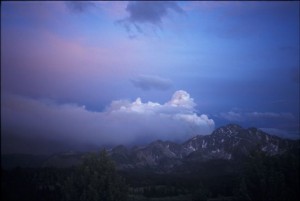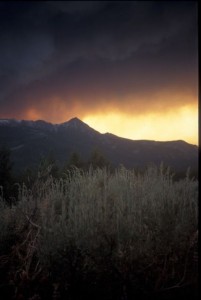The green double jogger, parked in the backyard last night, has a coating of ash on it this morning, fine particles that crumble when I touch them. The air smells like fire, albeit relatively far-away fire, just a hint of smoke, like campfires on the next campground loop. While the western sky is nearly clear, the eastern sky hazes to white near the horizon. I looked up Oregon’s current forest fires when I noticed the flat orange sky yesterday afternoon. It looks like the Tumblebug is the nearest, so it’s probably the one coloring our skies; it’s burning southeast of Oakridge. (click on the northernmost fire icon, then on the fire’s name, the Tumblebug complex, to find information, updated daily, about the fire).
When I walked out and sniffed the air this morning, it quickly brought me back to my former life, when I was only responsible for ten screaming college students. In 2003, I instructed a course that crossed from the west side of northern Washington’s North Cascades east across the Pasayten Wilderness, on the dry side of the mountains. This was my favorite course in five years of on-and-off working for the National Outdoor Leadership School: great co-instructor, fun student group, and, boy, what a beautiful and varied route. In late June, we launched into the cold, camping on thick, wet snow the first night. As we headed east, we crossed through many different bioregions, from west-side rainforests to mountain hemlock krummholz and passes above treeline, then into the grass and gravel of the Pasayten.
We hiked through much evidence of forest fire, both recent (within the last two years) and from the late 80s. At our second re-ration, the horsepacker gave us maps from our program supervisor for British Columbia’s Cathedral Park, our escape(!) if we couldn’t hike around or through the fire burning east of us, toward which we were walking. We supervised our students closely, making sure we knew where they were as they traveled without us during the last four days. A single ridge separated us from the conflagration in the end, as we awaited our pick-up at the trailhead. If the fire had come over the mountain, we were set to start walking, quickly, down along the gravel road out of the mountains. The nearest water was a mile back along the trail, a trickle.








